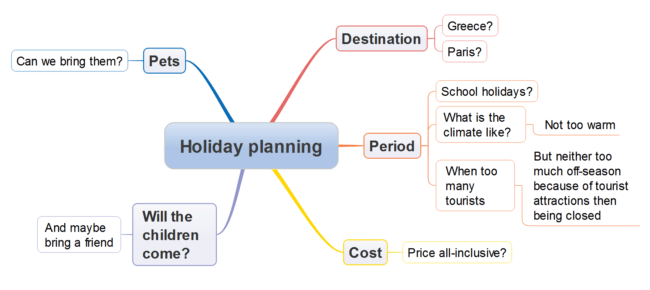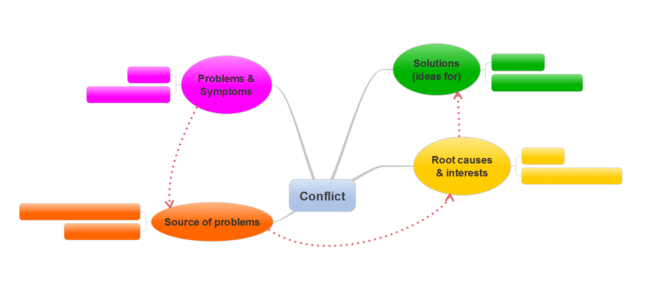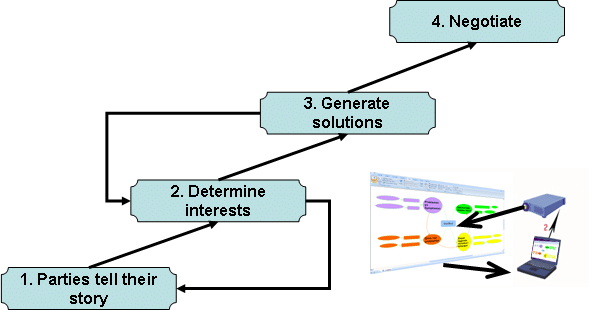We are looking at a customer-supplier IT outsourcing relationship. Over the years, many problems and irritations have escalated until a point where the customer finds it unacceptable to continue as-is and suggests his supplier to engage an independent mediator to solve their disputes. The objective of the mediation is to continue the collaboration and prevent formal litigation. This situation is classic for IT outsourcing: a customer is disappointed regarding services delivered and thinks he does not get what he needs or is entitled to, regularly feels not well served by supplier personnel, and is distrustful with regard to the accuracy of invoices. The supplier experiences his customer as over-demanding, loss-leading, and unpleasant to work for. The chosen mediator uses an approach that many may find unorthodox and innovative.
Approach
The approach is based on the possibilities of mind mapping software in combination with Dialogue Mapping™ [1] facilitated discussion.
Mindmapping is a technique that graphically records information in branches around a central theme[2] (see illustration 1).
Illustration 1: mind mapping example
Mind mapping is a technique well suited to follow and capture the complexities of human thinking. One can easily jump from left to right, from more general to specific, along with associations in one’s own brain, or with the turns in a discussion.
Mindmapping can be done by hand on a whiteboard or flipchart, or on the computer. Dialogue Mapping™ uses a drawing technique that looks like mind mapping, but it is mainly a methodology for facilitation of group discussions. It was developed by Jeff Conklin[3], to be used with groups with strongly divergent views, interests, and insights regarding an ideal solution to a conflict. To look for the one and only perfect solution in such a situation is a hopeless effort. It is much better to develop a shared understanding in the issue at hand, acknowledge mutual interests, and look for a solution that is sufficiently acceptable to all stakeholders.
Dialogue Mapping™ applies this approach in a methodology with guidelines for facilitating group discussions[4]. Software is a crucial tool used to capture, structure, and visualize group insights.
Practice
In the current case, the approach above has been applied. The group was very small; just two people besides the facilitator. Each party had one representative at the table, with a mandate for complete and open exploration and negotiation to achieve a joint draft solution of the conflict. The final settlement would be with the highest management of both organizations.
With the two representatives, multiple mind mapping sessions were conducted at intervals of roughly 2 weeks. Each session lasted about two hours. The facilitator-led the discussion and recorded information from the discussion in Mindmapping software. The Mindmap thus created was displayed with a computer beamer. Between sessions, the facilitator analyzed and restructured the mindmap[5].
At the start of mediation, it took three sessions to capture and unravel the main issues and relational aspects of the conflict. After that, specialists of both parties collaborated to retrieve facts about delivered services and payments. Based on the information thus obtained, the facilitator, on behalf of both parties, composed a document describing the basis and characteristics of the conflict including consolidation of facts concerning delivery and payments. The document also contained solutions for different aspects of the conflict. Following this document, the directors of the parties in conflict arranged a settlement.
Observations, what happened?
What happened during the process, what was remarkable, how did things go?
In the first place, it turned out that both parties had no problem at all taking part in a mind mapping facilitated discussion. Apparently, it is sufficiently intuitive, at least for the participants involved (both had been professionals in the IT world for a long time).
At the start of the process, it took not long for the facilitator and participants to take stock of the different problems within the context of the contracted service. This concerned e.g. performance issues, (not) fulfillment of contractual obligations, transparency of invoicing and adjustments, but also mutual treatment between employees of both parties.
The dynamics over consecutive sessions are quite interesting. The conversation mood developed from hostile, tense, and formal to rather open and constructive. This happened in each session but also did every next conversation move the next step towards a more positive and constructive atmosphere.
Content-wise this came together with a change of subject matter. The first session, of course, looked into acute problems, irritations about the collaboration, and symptoms of a bad relationship. As mind mapping created a shared insight into this problem side, and each party had said their bit, the discussion gave participants room to jointly look at the origins of problems. At that stage parties already were much less finger-pointing at each other. There was a willingness to blame oneself for causing the bad functioning of the collaboration. Parties already often went alongside by side in the discussion, and jointly looked into the (root) causes of their problems, to be able to initiate fundamental changes. At last, the conversation generated many solutions for identified problems, and this involved true collective creativity: one party suggested the beginning of a solution, the other side built on that, and so on.
Illustration 2, Structure of the mindmap after analysis
This way it took only a few sessions to unravel problems and generate ideas to both solve surface issues and take away root causes. (see illustration 2, Structure of the mindmap after analysis). Thus, a limited investment in effort and elapsed time achieved a substantial improvement in the collaboration between both parties’ representatives, who as managers were the leading men in the conflict. Both had gained a better understanding and respect for the other. And they had the will and enthusiasm to implement the necessary changes that would improve the mutual collaborative relationship also structurally and broadly in both organizations.
For a complete solution of the conflict, there was still the need to create sufficiently transparent insight into factual delivery and payments, and possible corrections to these. To this end, both parties got down to the bottom of their accounts. This was a separate task for a team of specialists from both sides. The process took months to complete and resulted in detailed and consolidated reports on costs and deliveries.
Results
In the end, the mediation resulted in an overview of problems and solutions, and mutual financial claims, used by the highest management of both parties for a final negotiation, resulting in a settlement that is satisfactory for both parties. It is unclear whether designed solutions to (root) causes have been implemented.
Summarizing the effects of the use of mind mapping based mediation are:
De-escalation, immediately, with a positive contribution to mediation
- Time and détente to work on a solution
- Formal litigation (going to court) prevented
- No damage to public reputation
- No precedent for future relationships (suppliers and customers)
The basis for recovery of the relationship: insight and mutual understanding
- Content: insight and overview of a complex problem area
- Relationship and emotionally: drivers, interests, frustration
Basis for settlement
- Inventory of delivered services and payments
- Solutions to structurally tackle identified problems
Conclusion and recommendations
The role of mind mapping
Computer-mind mapping contributes in a positive way to a group discussion: it structures the process, documents it too still during the discussion, and thus constitutes a collective memory. It also forces one to express thoughts clearly and makes matters transport.
Furthermore, mind mapping specifically contributes to the objectives of mediation at three points.
In the first place, the technique promotes a shared understanding of the situation. The mindmap that is being developed becomes a collective document that in practice every participant wants to contribute to. In the end the mindmap contains a shared image of shared problems, as well as specific problems and solutions for each side.
Secondly, the use of mind mapping evens out the balance of power between participants. It neutralizes some forms of cheating in the negotiation because it forces to capture the essence of statements in writing in the mindmap. Thus it works counter to e.g. ‘truth by repetition’, riding hobbyhorses, intimidation, use of power, insults, et cetera. Furthermore, the technique temporizes the conversation as capturing information in the mindmap is slower than the speed of speech.
Finally, mind mapping depersonalizes the conflict. The displayed mindmap can draw away attention from the individuals, as the objective area where each participant’s views are visualized [6], and it is undeniable proof that the opinion of each participant has been said and heard.
Application
Mediation with the use of mind mapping fits in the standard facilitative process approach of mediation[7], summarized in four steps (see illustration 3).
Illustration 3: Four steps in the standard facilitative process approach of mediation
When to use the mind mapping approach, and when not to? A few conditions have already been mentioned: parties should feel comfortable with computers, and the mediator must be able to operate mind mapping software ‘in the blind’. Besides that, there should be enough time between meetings to analyze and restructure the mindmap.
Mediation with the use of mindmaps seems to be best geared for complex conflicts in business, where both the factual situation is complex and human relationships are disturbed.
BOX I
Mediation types; one concept, many variants
Mediation is Alternative Dispute Resolution; most often an alternative to going to court. Characteristic is that parties participate voluntarily and come to a conflict decision themselves, being assisted by an independent third party mediating in strict confidentiality. In this respect mediation is different from other forms of conflict intervention such as autonomous negotiation, going to court, arbitration, or “binding advice”[8] by an expert. In mediation, many variants exist, and the choice depends on the nature of the conflict and the preference of the mediator. The mediator may, for example, choose to act as the facilitator guiding the process between parties (so-called facilitative mediation), or he may be the expert steering on content (evaluative mediation). Furthermore, the mediation may primarily be aimed at achieving a content-matter solution for the conflict (as with a business conflict over the delivery of goods), or the recovery of a relationship (as often is needed in conflicts in the family or between neighbors).
BOX II
Success of ICT-mediation
Both professional organizations and suppliers of ICT-mediation claim relatively high success rates. At the Nederlandse Stichting Geschillenoplossing Automatisering (SGOA, Dutch Foundation for Dispute Resolution in IT) more than 87% of ict-mediations are successful (www.sgoa.org), at the World Intellectual Property Organization (WIPO, UN-organisation) the success rate is 73% of cases against e.g. 58% in arbitration (http://www.wipo.int/amc/en/center/caseload.html). A warning should go with these high scores. Mediation requires voluntary participation by both parties, and these will assess their interests and chances beforehand. This is likely to cause a preselection of cases to be proposed for mediation: cases well suited for mediation. There are no public statistics available on mediation in ict-outsourcing. The reason for this may be twofold: there are not so many outsourcing mediations, and cases with large organizations and substantial interests are often kept completely indoors (smallscale survey by VIRA on collaboration with SGOA, 2010).
[1] ™ CogNexus Institute
[2] Mind Mapping techniques have been around for centuries, but the authorship of the modern-day
version is claimed by the British psychologist Tony Buzan.
[3] Conklin, Jeff (2006) Dialogue Mapping, John Wiley
[4] The guidelines apply to the group process, and the specific question and answer patterns that the facilitator elicits from discussion participants, and records. The author of this article did use the guidelines for the group process, but not for the question and answer patterns.
[5] Software used: iMindQ version 8.
[6] This makes one think of narrative mediation, during which the mediator may point at a point in the room representing “the problem”.
[7] Leaving out the formal head and tail activities as prescribed by the Nederlands MediationInstituut (Dutch Mediation Institute).
[8] Instrument in Dutch law.
About the author
Joost van Boeschoten (1956, Dr.) is an independent consultant with Contrasticon BV working with senior management of ICT customers and their suppliers, helping them create successful form and content for their collaborative relationships.
In the past, Joost van Boeschoten worked with Computer Sciences Corporation (CSC) as an ICT-management consultant and Regional Director Research Services.






